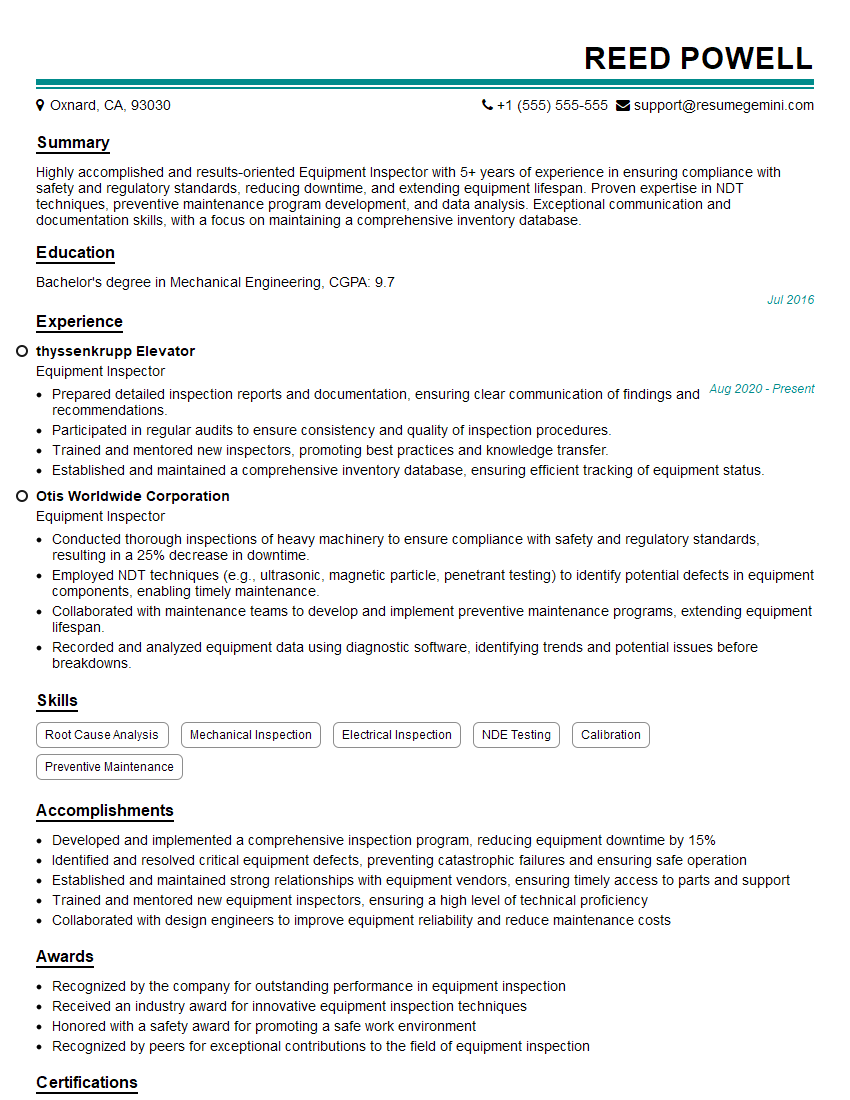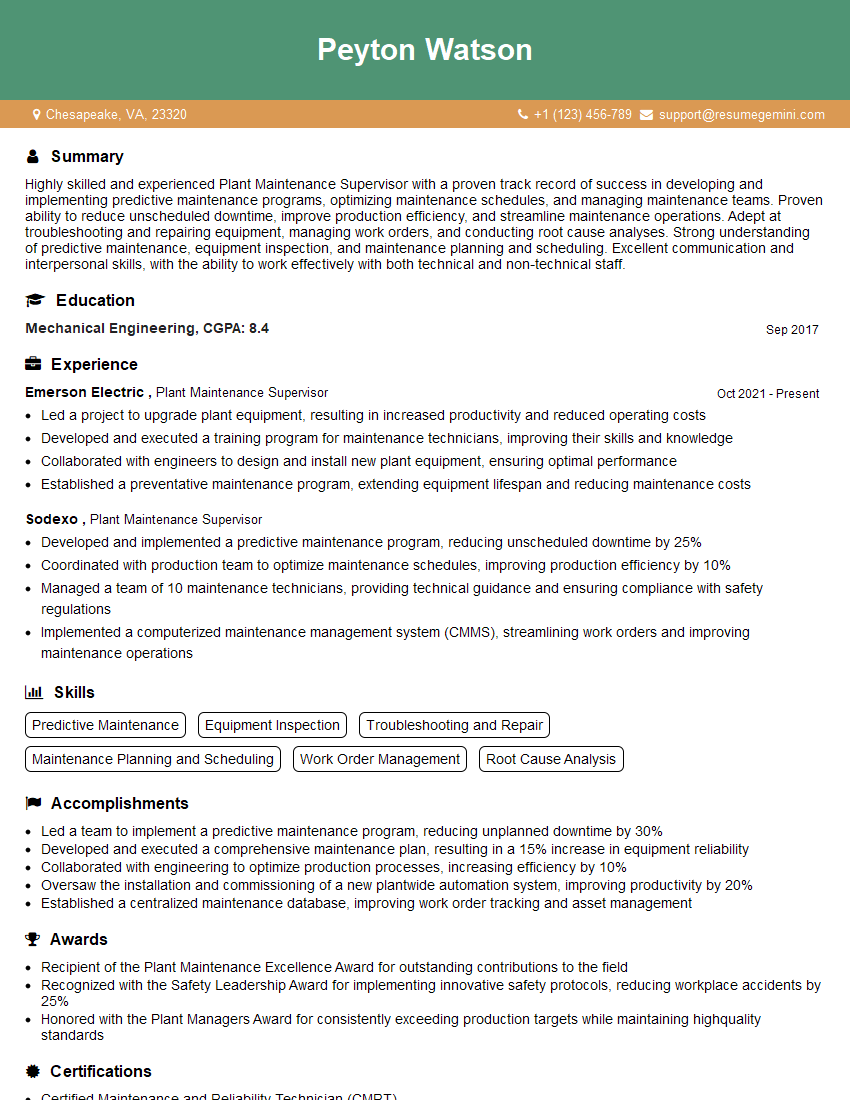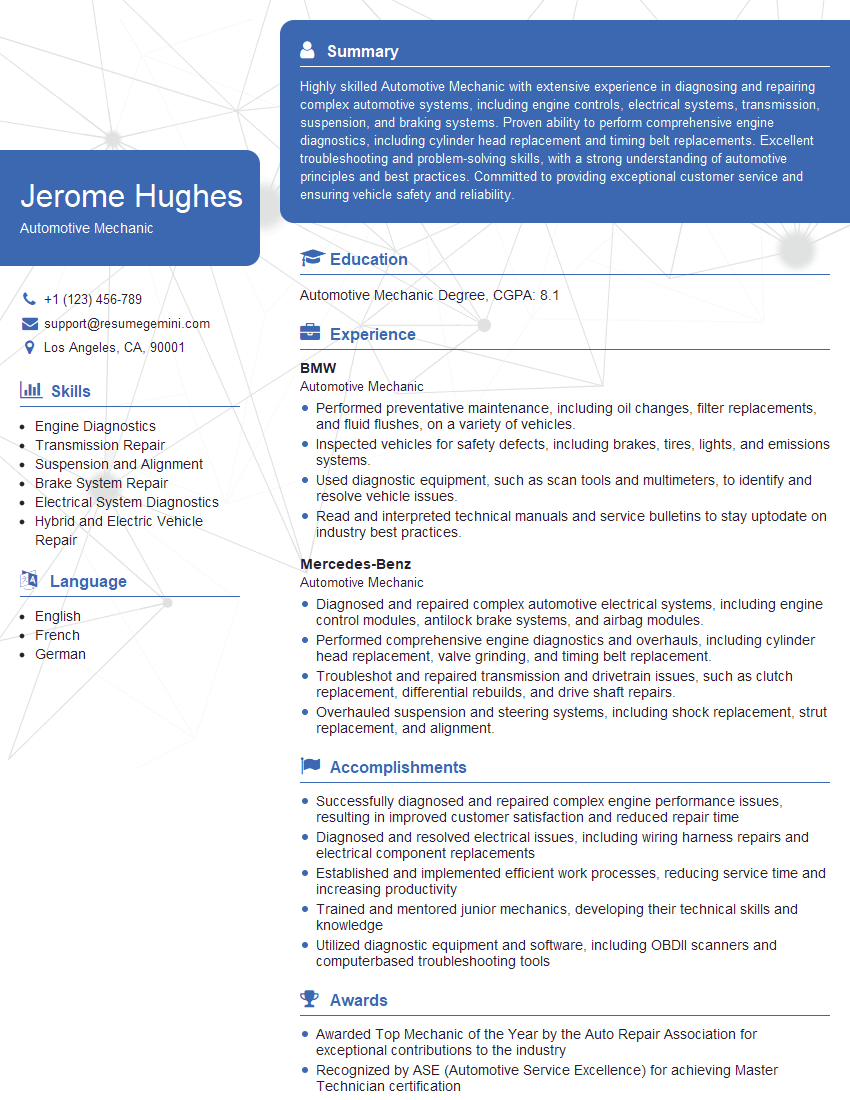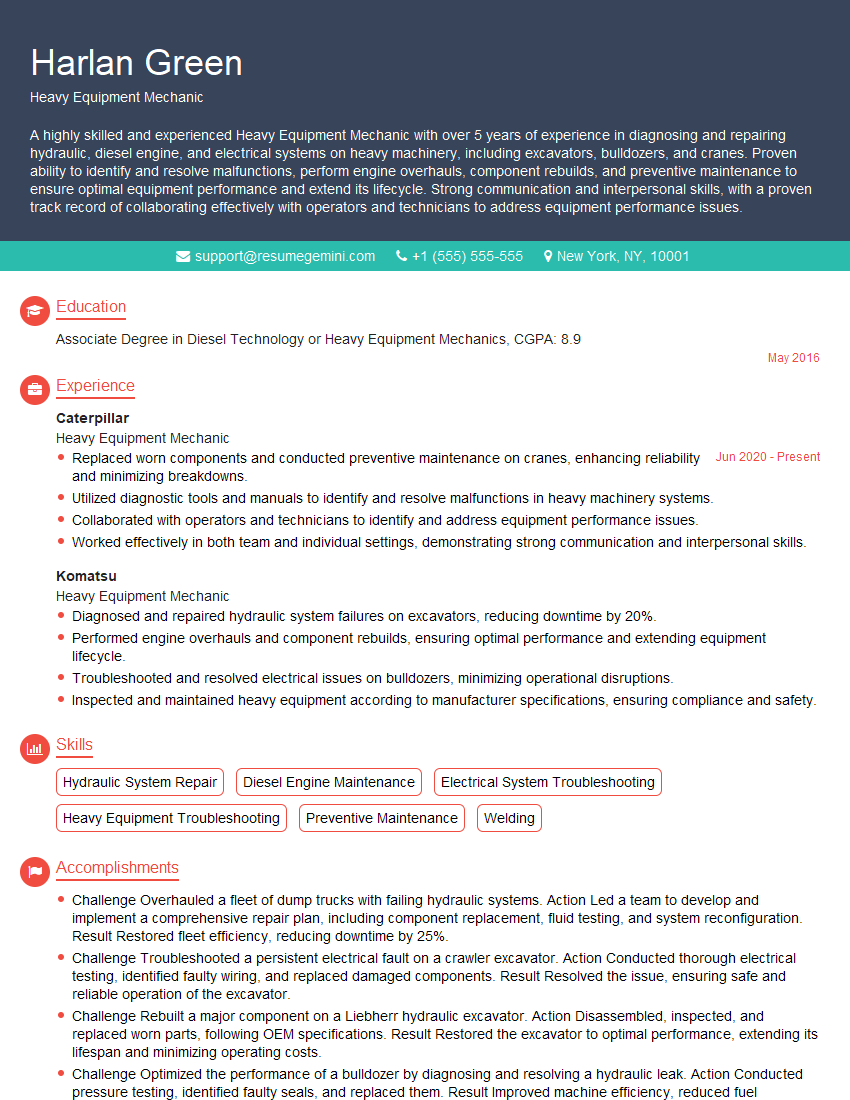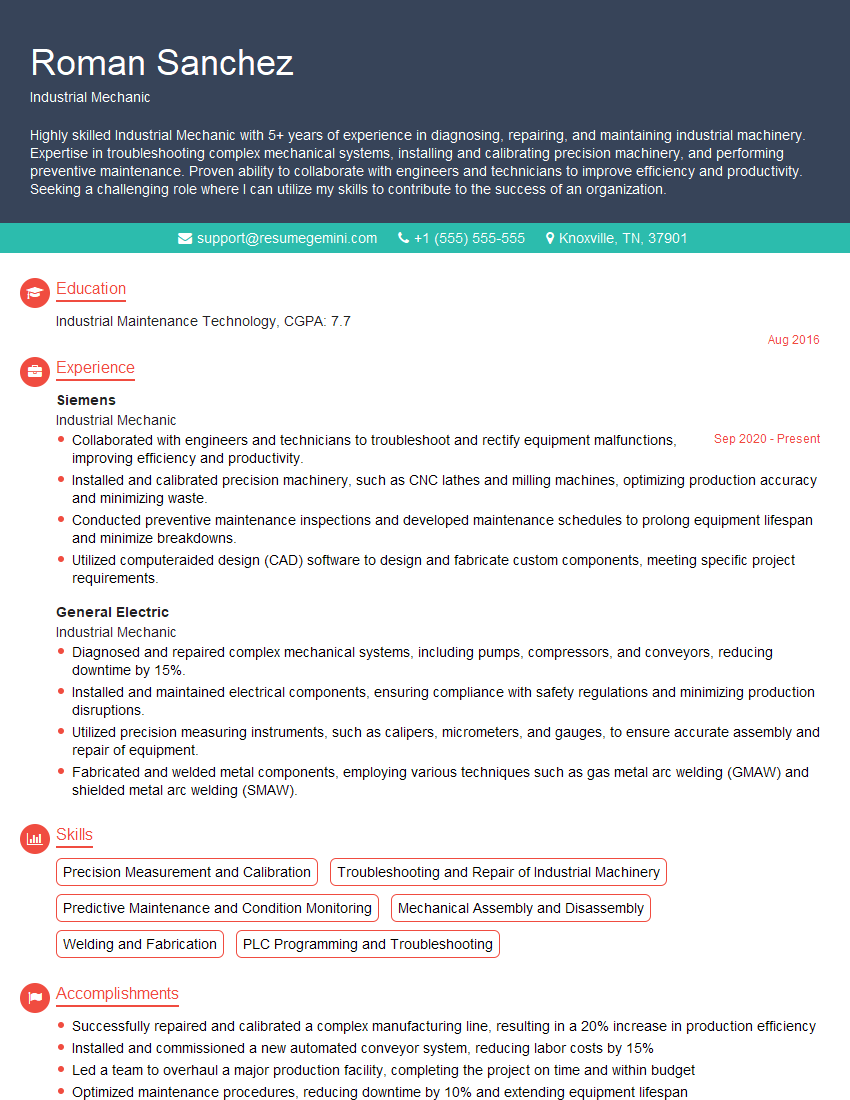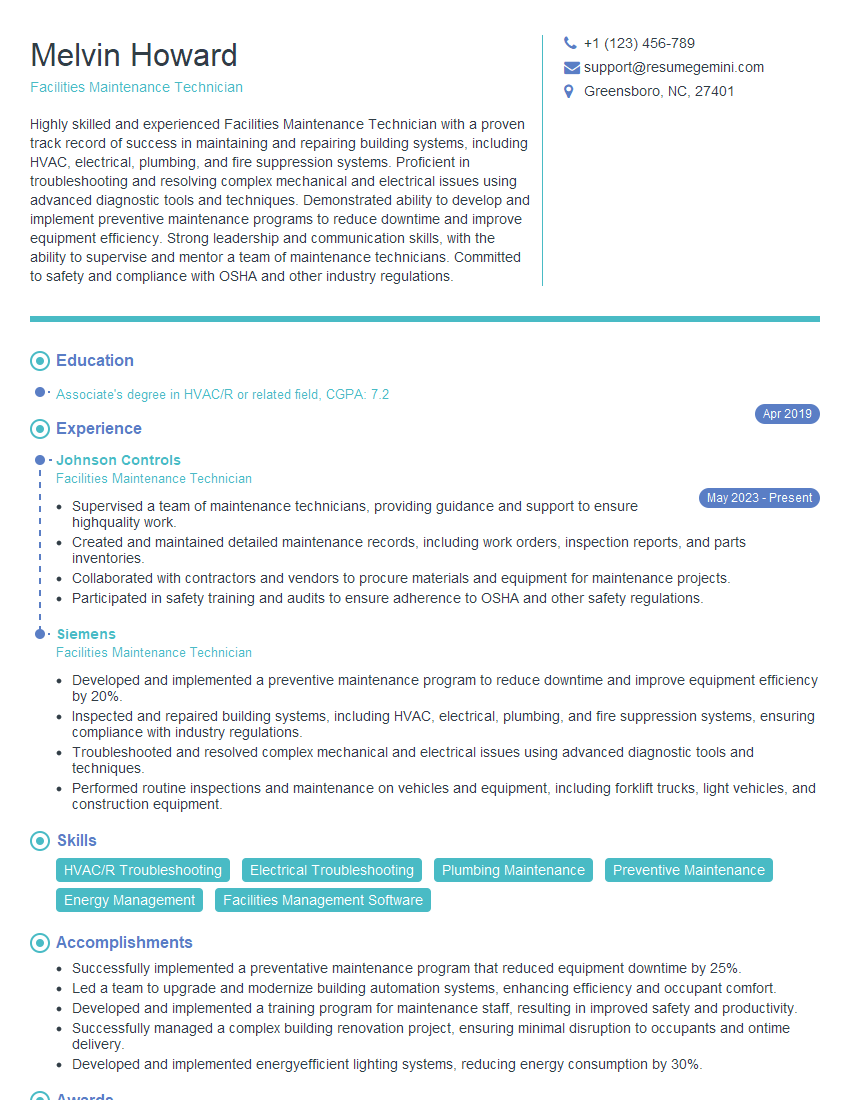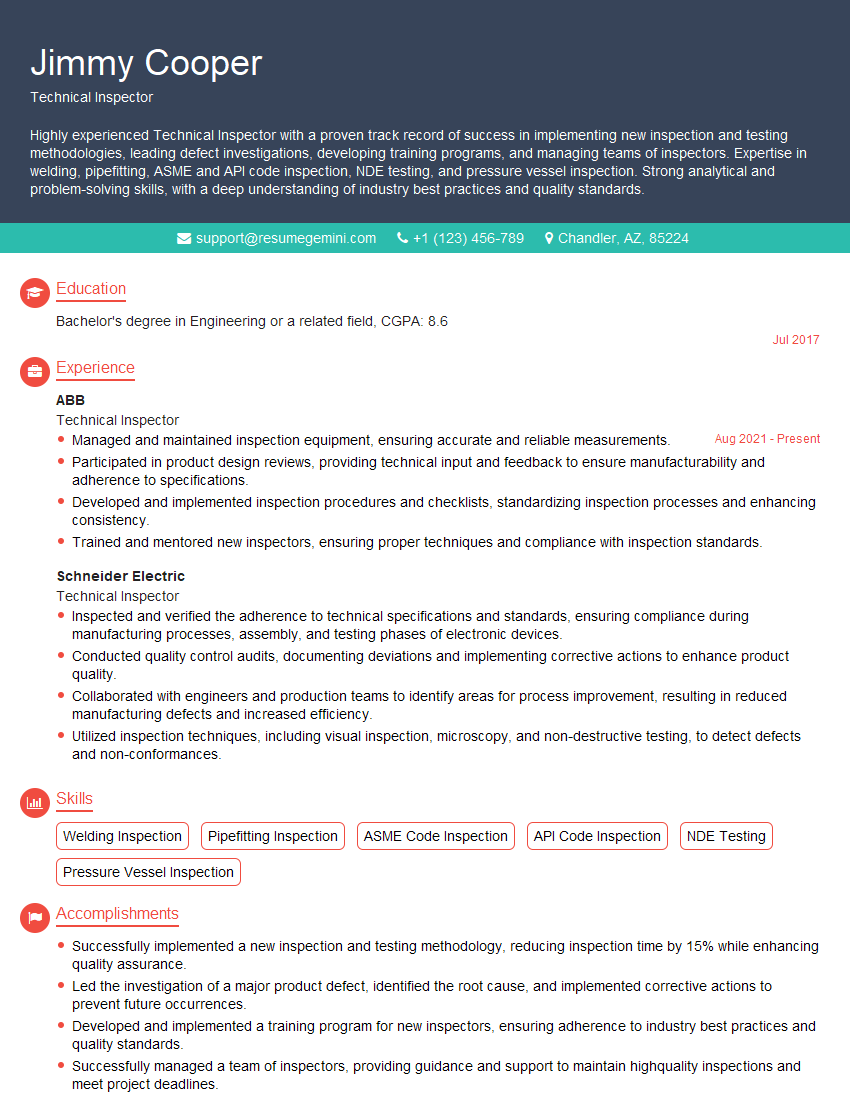Are you ready to stand out in your next interview? Understanding and preparing for Conduct routine maintenance and inspections of equipment interview questions is a game-changer. In this blog, we’ve compiled key questions and expert advice to help you showcase your skills with confidence and precision. Let’s get started on your journey to acing the interview.
Questions Asked in Conduct routine maintenance and inspections of equipment Interview
Q 1. Describe your experience with preventive maintenance schedules.
Preventive maintenance schedules are the backbone of efficient equipment management. They’re essentially a roadmap outlining planned tasks to keep equipment running smoothly and prevent costly breakdowns. I’ve extensive experience developing and implementing these schedules, tailoring them to the specific needs of diverse equipment and operational environments.
For example, in my previous role at a manufacturing plant, I developed a comprehensive preventive maintenance schedule for our automated assembly line. This involved creating a detailed calendar of tasks like lubrication, cleaning, and component inspections, all performed at specific intervals based on manufacturer recommendations and historical data. We used a computerized maintenance management system (CMMS) to track these schedules, send automated reminders, and generate reports on maintenance history. The result was a significant reduction in unplanned downtime and improved overall equipment effectiveness (OEE).
Another example involves creating a preventative maintenance schedule for a fleet of delivery trucks. This included regular checks of tires, brakes, and fluid levels, all at specific mileage intervals. Regular servicing and checks prevented road accidents, ensured compliance with regulations, and ensured operational efficiency.
Q 2. Explain the importance of conducting regular equipment inspections.
Regular equipment inspections are crucial for ensuring safety, maximizing operational efficiency, and extending the lifespan of equipment. Think of it like a regular health checkup for your machinery – catching small problems early prevents them from becoming major, costly issues.
For example, a timely inspection might reveal a loose bolt on a conveyor belt before it leads to a complete system failure and production stoppage. Similarly, detecting wear and tear on a machine’s components during a routine inspection allows for proactive replacement, preventing unexpected breakdowns and minimizing downtime. Regular inspections also help in identifying potential safety hazards before they cause accidents or injuries.
In short, conducting regular inspections is a proactive approach that significantly reduces the risk of equipment failure, enhances safety, and ultimately contributes to cost savings in the long run.
Q 3. What are the common indicators of equipment malfunction?
Recognizing the signs of equipment malfunction requires a keen eye and a thorough understanding of the equipment itself. Common indicators can range from subtle changes in performance to obvious signs of distress.
- Unusual noises: Grinding, squealing, or unusual vibrations can indicate problems with bearings, gears, or other moving parts.
- Leaks: Oil, water, or other fluid leaks are often a clear indication of a seal failure or other component damage.
- Performance degradation: A noticeable drop in output, speed, or efficiency can be a sign of wear and tear or a malfunctioning component.
- Unusual smells: Burning smells often indicate overheating or electrical problems.
- Overheating: Excessive heat generation can indicate friction, electrical faults, or inadequate cooling.
- Erratic readings on gauges or meters: Unexpected changes in pressure, temperature, or voltage readings can signal underlying issues.
- Visible damage: Cracks, dents, or other physical damage to components should be addressed immediately.
It’s important to remember that the specific indicators will vary depending on the type of equipment. For instance, a change in the RPM of a pump or motor is an obvious indication that there’s an issue that needs to be addressed.
Q 4. How do you prioritize maintenance tasks?
Prioritizing maintenance tasks is essential for maximizing efficiency and minimizing downtime. I utilize a multi-faceted approach, combining several criteria to determine the urgency and importance of each task.
- Criticality: Tasks impacting critical equipment or essential processes are prioritized. For instance, repairing a broken compressor in a manufacturing plant takes precedence over routine lubrication.
- Urgency: Tasks that require immediate attention due to safety risks or potential production disruptions are prioritized. For instance, a leaking hydraulic line needs urgent attention.
- Cost: The potential cost of failure is considered; preventing a catastrophic failure is prioritized over a minor repair.
- Preventative vs. Corrective: Preventive maintenance is generally prioritized over corrective, as it prevents future problems.
I often use a CMMS (Computerized Maintenance Management System) which helps in assigning risk scores and prioritizing maintenance activities. This allows me to effectively manage work orders, ensuring that the most critical and urgent tasks are addressed first, contributing to efficient and safe operations.
Q 5. Describe your experience with different types of maintenance (preventive, corrective, predictive).
My experience encompasses all three major types of maintenance: preventive, corrective, and predictive.
- Preventive Maintenance: This involves scheduled inspections and servicing to prevent equipment failure. I’ve extensive experience developing and implementing preventive maintenance schedules, as discussed previously. This is the most proactive approach and leads to reduced downtime and increased equipment longevity. An example is regularly changing the oil in a vehicle.
- Corrective Maintenance: This focuses on repairing equipment after a failure has occurred. This reactive approach is costly and disrupts production but is essential when preventive maintenance fails. I’m skilled in diagnosing problems, performing repairs, and troubleshooting equipment malfunctions. For example, replacing a broken motor after it fails is corrective maintenance.
- Predictive Maintenance: This utilizes technology like vibration analysis, thermal imaging, and oil analysis to predict potential failures before they happen. This data-driven approach allows for more precise scheduling of maintenance, minimizing unnecessary downtime. An example is using vibration sensors to detect bearing wear and schedule replacement before failure.
I’ve successfully implemented a combination of these maintenance strategies in various settings to achieve optimal equipment reliability and operational efficiency.
Q 6. How do you document maintenance activities and findings?
Meticulous documentation is paramount in equipment maintenance. It provides a complete history of equipment performance, maintenance activities, and any identified issues.
I typically use a CMMS (Computerized Maintenance Management System) to record all maintenance activities. This includes:
- Work orders: Detailed descriptions of the task, including date, time, technician, parts used, and labor hours.
- Inspection reports: Documentation of findings during routine inspections, including any observed defects or potential issues.
- Repair reports: Comprehensive accounts of repair procedures, including parts replaced, troubleshooting steps, and testing results.
- Preventative Maintenance Schedules: Detailed logs of preventative maintenance activities.
These records are crucial for tracking equipment performance, predicting future maintenance needs, and ensuring compliance with safety regulations. Good documentation also facilitates efficient troubleshooting and minimizes downtime in the event of future issues.
Q 7. What safety procedures do you follow during maintenance and inspections?
Safety is my top priority during all maintenance and inspection activities. I strictly adhere to established safety protocols and procedures, which are often company-specific but always follow industry best practices.
- Lockout/Tagout (LOTO): I always follow LOTO procedures to de-energize equipment before performing any maintenance or repair work, preventing accidental starts and injuries. This is a fundamental safety measure.
- Personal Protective Equipment (PPE): I consistently use appropriate PPE, such as safety glasses, gloves, hearing protection, and safety shoes, to protect myself from hazards.
- Risk assessment: Before starting any task, I conduct a risk assessment to identify potential hazards and develop safe work procedures. This could include the use of additional safety equipment based on the work being performed.
- Following all safety training and guidelines: I’m always up-to-date with the latest safety training and company policies. Staying compliant with regulations ensures the safety of myself and the people around me.
- Reporting near misses and accidents: I believe in promptly reporting any incidents, near misses, or unsafe conditions to my supervisor. This helps prevent future incidents.
My commitment to safety is unwavering, and I ensure that all maintenance activities are performed in a manner that protects both personnel and equipment.
Q 8. How familiar are you with using computerized maintenance management systems (CMMS)?
I’m highly proficient with CMMS (Computerized Maintenance Management Systems). My experience spans several platforms, including [Mention specific CMMS software, e.g., Fiix, UpKeep, IBM Maximo]. I’m comfortable using them for scheduling preventative maintenance, tracking work orders, managing inventory, generating reports, and analyzing equipment performance data. Think of a CMMS as a central brain for all maintenance activities, ensuring efficiency and preventing costly downtime. For example, in a previous role, we used a CMMS to schedule preventative maintenance on our large-scale manufacturing equipment, reducing unplanned downtime by 25% within six months.
Beyond the basics, I understand how to configure CMMS systems to meet specific organizational needs. This includes customizing work order templates, setting up preventative maintenance schedules based on manufacturer recommendations and equipment usage, and establishing key performance indicators (KPIs) to track maintenance effectiveness. Data analysis within the CMMS is crucial; I can leverage the system’s reporting capabilities to identify trends, predict potential failures, and optimize maintenance strategies.
Q 9. Describe a time you had to troubleshoot a complex equipment issue.
During my time at [Previous Company Name], a critical piece of our automated packaging line—the high-speed label applicator—malfunctioned. Initially, it displayed an error code that wasn’t in the manual. My troubleshooting started with systematically checking the obvious: power supply, sensor connections, and air pressure. Finding nothing immediately wrong, I consulted the electrical schematic diagram and began systematically testing components.
I discovered a loose connection in a control circuit that was causing intermittent signal failures. The intermittent nature of the problem had initially masked its cause. While tightening the connection resolved the immediate problem, I also used the opportunity to inspect the entire wiring harness for wear and tear and replaced several aging components as a preventative measure. This systematic approach, combining practical hands-on investigation with a review of the technical documentation, resolved a potentially costly production delay.
Q 10. What are some common causes of equipment failure, and how can they be prevented?
Equipment failure stems from various sources, broadly categorized as mechanical, electrical, and environmental factors. Mechanical failures can result from wear and tear (like bearing wear), fatigue (from repeated stress), or improper lubrication. Electrical failures often arise from faulty wiring, damaged components (capacitors, motors), or power surges. Environmental factors such as excessive temperature, humidity, or vibration can also degrade equipment over time.
Prevention involves a multi-pronged approach. Regular preventative maintenance, adhering to manufacturer’s recommendations, is crucial. This includes lubrication schedules, visual inspections for wear, and timely replacement of parts approaching their end-of-life. Implementing robust safety procedures to avoid overloading equipment or exposing it to harsh conditions is also essential. For example, regular cleaning of cooling systems prevents overheating, and proper grounding reduces the risk of electrical damage. A CMMS assists greatly in tracking and ensuring these preventative steps are executed.
Q 11. How do you interpret equipment manuals and technical drawings?
Interpreting equipment manuals and technical drawings requires a methodical approach. I start by reviewing the table of contents and index to locate relevant sections. I carefully examine diagrams to understand the equipment’s layout, component relationships, and operational principles. Technical drawings often use standardized symbols and notations that I’m proficient in deciphering. For example, understanding a piping and instrumentation diagram (P&ID) is critical for working on process equipment.
I cross-reference diagrams with textual descriptions to gain a complete understanding of how different parts interact. When troubleshooting, I often use highlighted sections in the manual to pinpoint specific components or troubleshooting steps. Online resources and manufacturer websites are also invaluable aids in understanding obscure information or finding updated documentation.
Q 12. What tools and equipment are you proficient in using?
My tool proficiency spans a broad range, encompassing both hand tools and specialized equipment. I’m adept at using standard hand tools such as screwdrivers, wrenches, pliers, and multimeters. I’m also skilled in using power tools like drills, grinders, and impact wrenches. Specific to maintenance, my experience includes using diagnostic equipment such as oscilloscopes, thermal imagers, and vibration analyzers.
Beyond this, my experience extends to the use of specialized equipment related to different machinery, such as hydraulic presses, pneumatic systems, and PLC controllers. Safety is paramount. I always adhere to all relevant safety protocols and wear appropriate personal protective equipment (PPE) when using any tools or equipment.
Q 13. How do you ensure the accuracy of your maintenance records?
Accuracy in maintenance records is critical for ensuring accountability, tracking equipment history, and supporting warranty claims. I maintain meticulous records by using a standardized format (often dictated by the CMMS system). This includes detailed descriptions of the work performed, parts used (including serial numbers and part numbers), and the time spent. I always double-check information for completeness and accuracy before submitting any records.
Digital record-keeping through CMMS greatly assists in accuracy. Using photos or videos to document the before and after state of repairs is highly beneficial, creating a visual record for future reference. Regularly auditing my records against the physical equipment and comparing them against the CMMS database is a key step in ensuring data integrity.
Q 14. How do you manage your workload effectively during peak maintenance periods?
Managing workload during peak periods demands effective planning and prioritization. I use a combination of techniques to ensure efficiency. First, I carefully review all scheduled maintenance tasks and prioritize them based on urgency and criticality—this is often already prioritized within the CMMS system. This might involve using a prioritization matrix to balance preventative and corrective maintenance needs.
Communication is key. During peak periods, I maintain open communication with my supervisors and colleagues to manage expectations and redistribute tasks as needed. I also proactively identify potential bottlenecks and address them before they impact productivity. For instance, if a specific part is frequently needed, I’ll coordinate with procurement to ensure sufficient inventory. By proactively addressing potential issues and maintaining a clear communication pipeline, I ensure that even during the busiest periods, we remain efficient and productive.
Q 15. Describe your experience with different types of equipment (e.g., mechanical, electrical, hydraulic).
My experience spans a wide range of equipment, encompassing mechanical, electrical, and hydraulic systems. In my previous role at Acme Manufacturing, I routinely maintained conveyor systems (mechanical), PLC-controlled automated packaging lines (electrical), and hydraulic presses used in metal forming (hydraulic). With the conveyor systems, I was responsible for inspecting belt tension, lubrication of bearings, and the replacement of worn rollers. For the automated lines, I diagnosed and repaired electrical faults, programmed PLCs for adjustments and troubleshooting, and worked on the sensor systems. With the hydraulic presses, I monitored oil levels and pressure, inspected seals and hoses for leaks, and performed regular filter replacements. This diverse experience has given me a solid understanding of the unique maintenance needs of each system type. For instance, understanding the nuances of hydraulic fluid viscosity at different temperatures is crucial for preventative maintenance and avoiding costly breakdowns. Similarly, proficiency in electrical schematics is essential for efficiently troubleshooting PLC-controlled systems.
Career Expert Tips:
- Ace those interviews! Prepare effectively by reviewing the Top 50 Most Common Interview Questions on ResumeGemini.
- Navigate your job search with confidence! Explore a wide range of Career Tips on ResumeGemini. Learn about common challenges and recommendations to overcome them.
- Craft the perfect resume! Master the Art of Resume Writing with ResumeGemini’s guide. Showcase your unique qualifications and achievements effectively.
- Don’t miss out on holiday savings! Build your dream resume with ResumeGemini’s ATS optimized templates.
Q 16. How do you identify and address potential safety hazards during maintenance?
Safety is paramount in any maintenance operation. My approach involves a multi-step process. First, a thorough pre-maintenance inspection identifies potential hazards – exposed wiring, unguarded moving parts, high-pressure lines, or hazardous materials. I then implement appropriate control measures, such as lockout/tagout procedures (LOTO) to isolate power sources before starting any work on electrical equipment. I ensure the use of appropriate personal protective equipment (PPE), including safety glasses, gloves, and hearing protection, based on the specific task. Regular training on safety procedures and hazard identification helps maintain a safe working environment. For instance, before working on a hydraulic press, I would always check the pressure gauge to ensure it’s zeroed before opening any valves. This layered approach reduces the risk of accidents and ensures safety for myself and my colleagues.
Q 17. What is your experience with root cause analysis?
I’m proficient in root cause analysis (RCA), employing methodologies like the ‘5 Whys’ technique and fault tree analysis. For example, if a conveyor belt keeps breaking, the ‘5 Whys’ might go like this: 1. Why did the belt break? – Excessive wear. 2. Why was there excessive wear? – Improper tracking. 3. Why was the tracking improper? – Misaligned rollers. 4. Why were the rollers misaligned? – Worn mounting brackets. 5. Why were the brackets worn? – Lack of preventative maintenance. This process helps move beyond addressing the immediate symptom to uncovering the underlying cause, preventing recurrence. Fault tree analysis allows visualizing potential causes and their interactions, which is particularly beneficial in complex systems.
Q 18. Describe your experience with lubrication techniques and procedures.
My experience with lubrication encompasses a wide array of techniques and procedures, including the selection of appropriate lubricants based on equipment type and operating conditions, proper grease gun usage to ensure thorough lubrication without over-greasing, and the implementation of lubrication schedules based on manufacturers’ recommendations. I’m also familiar with different lubrication systems, such as centralized lubrication systems, which deliver lubricant automatically to multiple points, and manual lubrication systems. For example, when lubricating a bearing, I’d always follow the manufacturer’s specification for the type and amount of grease, ensuring that I don’t over-lubricate, which can lead to heat buildup and premature failure. I also meticulously document all lubrication activities, including dates, lubricants used, and equipment inspected, to aid in preventative maintenance.
Q 19. How do you handle unexpected equipment failures?
When unexpected equipment failures occur, my immediate response focuses on safety. I first secure the area, ensuring no one is at risk. Then, I start by assessing the situation to determine the extent of the damage and the potential safety hazards. This is often followed by a preliminary diagnosis using available data such as alarms or error messages. Depending on the severity, I either take immediate corrective actions or escalate the issue to my supervisor for assistance from specialized technicians. Following resolution, I document the failure, the corrective actions taken, and the root cause analysis findings. This helps prevent future occurrences. A recent example involved a sudden power outage on a critical production line. I immediately shut down the affected equipment and then coordinated with the electrical team to diagnose and restore power, minimizing downtime.
Q 20. How do you communicate maintenance issues effectively to supervisors and team members?
Effective communication is key. I utilize a multi-faceted approach, starting with clear and concise reporting. I use work orders and maintenance logs to detail issues, providing pertinent information such as error codes, observations, and the potential impact on production. For urgent issues, I directly inform my supervisor via phone or email, providing immediate updates on progress. For routine maintenance, I maintain a consistent record-keeping system. For team members, clear and precise instructions, diagrams and demonstrations are critical, enabling them to perform tasks effectively and safely. This ensures transparency and fosters a collaborative problem-solving environment.
Q 21. What are your preferred methods for training new maintenance personnel?
My preferred method involves a blend of hands-on training and classroom instruction. I start with a thorough introduction to safety procedures and equipment specifics. Then, I guide new personnel through various maintenance tasks, starting with simpler procedures and gradually increasing complexity. Shadowing experienced technicians provides practical exposure to real-world scenarios. I utilize visual aids, such as diagrams, videos, and checklists to reinforce learning. Regular feedback and performance evaluations help identify areas for improvement and track progress. This combination fosters a strong foundation in both theoretical knowledge and practical skills, ensuring new technicians can effectively and safely contribute to our maintenance team.
Q 22. How do you stay up-to-date on new maintenance technologies and best practices?
Staying current in the rapidly evolving field of maintenance technology requires a multi-pronged approach. It’s not enough to rely solely on past experience; continuous learning is key.
Professional Organizations and Publications: I actively engage with organizations like the Society for Maintenance & Reliability Professionals (SMRP) and subscribe to industry-leading journals and magazines. These resources provide insights into the latest advancements, best practices, and emerging trends.
Conferences and Workshops: Attending industry conferences and workshops allows me to network with peers and experts, learning from their experiences and discovering new technologies firsthand. For example, last year’s conference on predictive maintenance opened my eyes to the possibilities of AI-driven anomaly detection.
Online Courses and Webinars: Platforms like Coursera, edX, and LinkedIn Learning offer a wealth of online courses covering various aspects of maintenance, from specific software applications to advanced diagnostic techniques. I regularly dedicate time to completing relevant courses to broaden my skillset.
Manufacturer Training: I actively seek out training opportunities directly from equipment manufacturers. These sessions offer valuable insights into the specific maintenance requirements and best practices for the machinery we use, ensuring we maximize equipment lifespan and efficiency.
This combination of formal and informal learning keeps me informed and ensures I’m applying the most effective and efficient maintenance strategies.
Q 23. Describe your experience with maintaining compliance with safety regulations.
Safety is paramount in my work. Compliance with all relevant regulations is not just a matter of following rules; it’s a fundamental commitment to the well-being of myself and my colleagues. My experience spans various safety regulations, including OSHA (Occupational Safety and Health Administration) guidelines and industry-specific standards.
Lockout/Tagout Procedures (LOTO): I’m proficient in implementing LOTO procedures to ensure equipment is safely de-energized before maintenance. This involves meticulously documenting each step and verifying the safety of the process before starting any work.
Personal Protective Equipment (PPE): I always ensure the appropriate PPE is used, including safety glasses, gloves, hearing protection, and any other gear necessary for the specific task. Regular inspections of PPE are crucial to guarantee its effectiveness.
Hazard Communication: I’m familiar with hazard communication systems (SDS sheets) and understand the risks associated with different materials and chemicals used in maintenance. Proper handling and disposal procedures are strictly followed.
Incident Reporting: Any safety incident, no matter how minor, is documented and reported according to established procedures. This contributes to a culture of safety and helps identify areas for improvement in our safety protocols.
I regularly participate in safety training to stay informed about updates and best practices, ensuring our operations remain compliant and safe.
Q 24. What are your strengths and weaknesses in equipment maintenance and inspection?
My strengths lie in my methodical approach to problem-solving and my proactive approach to maintenance. I am skilled in diagnostic troubleshooting, preventative maintenance scheduling, and effectively managing resources. I’m also adept at training junior technicians and fostering a collaborative team environment.
One area I’m consistently working to improve is my time management when dealing with unexpected equipment failures. While I’m efficient in routine tasks, prioritizing urgent repairs and effectively allocating my time during crises requires ongoing refinement. To address this, I’m implementing a more structured prioritization system using a combination of risk assessment and impact analysis.
Q 25. How do you prioritize tasks when faced with multiple urgent maintenance requests?
Prioritizing multiple urgent maintenance requests requires a systematic approach. I use a three-step process:
Risk Assessment: I assess each request based on its potential impact on safety, production, and overall operations. A critical failure with significant safety implications or large-scale production downtime gets top priority.
Impact Analysis: I evaluate the consequences of delaying each repair. A minor issue that won’t significantly affect operations can be scheduled for later, even if it’s technically urgent.
Resource Allocation: Once the priority is established, I allocate resources (personnel, tools, parts) efficiently to address the most critical issues first. This often involves coordinating with team members to divide tasks effectively.
Imagine a scenario where a crucial conveyor belt stops unexpectedly, affecting the entire production line, alongside a smaller issue with a lighting fixture. Using this method, the conveyor belt repair would take precedence.
Q 26. Explain your experience with inventory management of maintenance supplies.
Effective inventory management of maintenance supplies is vital for smooth operations and cost control. My experience includes implementing and maintaining inventory management systems, tracking usage, and forecasting demand. This is crucial to avoid stockouts which can lead to production delays, and to prevent unnecessary overstocking of parts that tie up capital.
Inventory Tracking Software: I’m proficient in using inventory management software to track stock levels, order parts, and generate reports on usage patterns. This allows me to identify trends and optimize ordering procedures. For example, we switched to a cloud-based system which improved real-time visibility and collaboration.
Regular Stock Audits: Conducting regular physical stock audits ensures accuracy and helps identify discrepancies between physical inventory and system records. This helps prevent losses and ensures the system remains reliable.
Supplier Relationship Management: I maintain strong relationships with our suppliers, negotiating favorable pricing and lead times. This is especially important for critical parts.
Just-in-Time Inventory: Where feasible, implementing just-in-time inventory strategies can minimize storage costs and reduce waste by ordering parts only when needed.
By using a combination of technological tools and established inventory management practices, we can ensure that the right parts are available when needed, minimizing downtime and improving overall efficiency.
Q 27. Describe a time you had to work under pressure to resolve a critical equipment malfunction.
During a major storm, a critical cooling system for our server room malfunctioned, threatening a complete system shutdown. The situation was high-pressure as we had to act quickly to prevent significant financial loss and data disruption. Here’s how I handled the situation:
Rapid Assessment: I immediately assessed the situation, identifying the problem as a failed compressor in the cooling unit.
Prioritization: Given the critical nature of the problem, I prioritized getting a replacement compressor as quickly as possible while simultaneously implementing temporary cooling solutions (opening windows, using emergency fans).
Teamwork: I collaborated with the IT team, ensuring they understood the time-sensitive nature of the repair and the steps we were taking to mitigate the risk of data loss. This was crucial for a coordinated response.
Resource Management: I quickly located a spare compressor from a backup system, and coordinated with our maintenance team to expedite the replacement.
Problem Resolution: Within four hours, the replacement was successfully installed, and the cooling system was back online. Post-incident analysis revealed gaps in our backup systems and we implemented measures to avoid future issues.
This experience reinforced the importance of clear communication, efficient resource management, and a proactive approach to problem-solving under pressure.
Key Topics to Learn for Conduct routine maintenance and inspections of equipment Interview
- Preventive Maintenance Schedules: Understanding the importance of planned maintenance, creating and adhering to schedules, and the impact of neglecting preventative measures.
- Inspection Techniques and Documentation: Mastering visual inspections, using diagnostic tools (e.g., multimeters, pressure gauges), and accurately recording findings in logs or reports. This includes understanding relevant safety regulations.
- Troubleshooting and Basic Repair: Identifying common equipment malfunctions, performing basic repairs (within safety guidelines and skillset), and knowing when to escalate issues to more experienced personnel.
- Safety Procedures and Regulations: Demonstrating knowledge of relevant safety protocols, lockout/tagout procedures, and hazard identification for different types of equipment.
- Record Keeping and Reporting: Understanding the importance of accurate and timely reporting, including maintenance logs, incident reports, and communicating findings effectively to supervisors.
- Working with Different Equipment Types: Familiarizing yourself with the specific maintenance requirements of various equipment types relevant to the job description (e.g., mechanical, electrical, hydraulic systems).
- Understanding Equipment Manuals and Specifications: Demonstrating ability to interpret technical documentation, identify part numbers, and understand operational parameters.
- Problem-Solving and Critical Thinking: Highlighting your ability to analyze equipment performance, identify root causes of malfunctions, and develop effective solutions.
Next Steps
Mastering the skills of conducting routine maintenance and inspections is crucial for career advancement in many technical fields. It demonstrates responsibility, attention to detail, and a commitment to safety – qualities highly valued by employers. To maximize your job prospects, invest time in crafting an ATS-friendly resume that effectively showcases your skills and experience. ResumeGemini is a trusted resource to help you build a professional and impactful resume. Examples of resumes tailored to highlight experience in conducting routine maintenance and inspections of equipment are available to guide you.
Explore more articles
Users Rating of Our Blogs
Share Your Experience
We value your feedback! Please rate our content and share your thoughts (optional).
What Readers Say About Our Blog
good





